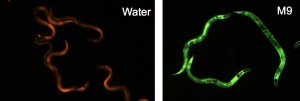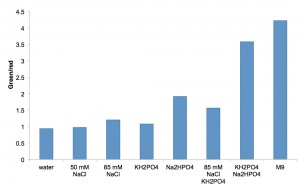The production of antimicrobial peptides (AMPs) is arguably the most conserved aspect of innate immunity in all organisms. For the last few years, much of our research has been focused on understanding the regulation of the related nlp and cnc AMP gene families in C. elegans. This has turned out to be surprisingly complex. They generally have very dynamic developmental expression profiles. This may be one reason why AMP genes frequently appear in lists of differentially regulated genes when two strains of worms are compared: even minor difference in the speed of development are sufficient to result in marked differences in AMP gene expression when samples are harvested at the same time rather than at a precise developmental stage.
Various stimuli affect the expression of different AMP genes. We’ve worked most with nlp-29, often relying on a standard reporter transgene, with GFP under the control of the nlp-29 promoter. Like the other members of the family, nlp-29 is expressed in hyp7. In young adults, nlp-29 expression is induced by infection with the fungus Drechmeria coniospora and by physical injury (Pujol et al., 2008). It is also induced by osmotic shock (Pujol et al., 2008). On the other hand, many stimuli that trigger the expression of stress-response genes, including starvation, heat-shock, heavy metals, or drugs like tunicamycin that induce an unfolded protein response do not up-regulate nlp-29 expression in young adults (Couillault et al., 2012). It is also, and this is a point we have tried to rectify in the literature (Wong et al., 2007), not induced by intestinal bacterial pathogens such as Serratia marcescens.
We have found that incubation of worms in M9 can also induce the expression of the nlp-29 reporter gene. After as little as 4 hours, GFP levels are increased by 2-fold, and leaving worms in M9 (with OP50) for 24 hours can provoke an increase of up to 20-fold (Figure 1). We carried out tests to see whether this increase was attributable to a single component of M9. Preliminary assays suggest that this isn’t the case (Figure 2), but we haven’t pursued our investigation further. Nor have we measured the expression level of other AMPs, but note that several of the genes in the nlp cluster appear to be controlled in the same way as nlp-29 (Pujol et al., 2008).
Our results do, however, suggest that as far as AMP gene expression is concerned, caution is needed when interpreting the results of any studies that involve incubation of worms in M9 for prolonged periods. We’ve reviewed our previously published results and do not believe it has been a problem. Nevertheless, we now routinely replace M9 with 50 mM NaCl.
Figures
References
Couillault C, Fourquet P, Pophillat M, and Ewbank J. (2012). A UPR-independent infection-specific role for a BiP/GRP78 protein in the control of antimicrobial peptide expression in C. elegans epidermis. Virulence 3, (Epub ahead of print). 
Pujol N, Cypowyi S, Ziegler K, Millet A, Astrain A, Goncharov A, Jin Y, Chisholm AD, and Ewbank JJ. (2008). Distinct innate immune responses to infection and wounding in the C. elegans epidermis. Curr. Biol. 18, 481-489. 
Pujol N, Zugasti O, Wong D, Couillault C, Kurz CL, Schulenburg H, and Ewbank JJ. (2008). Anti-fungal innate immunity in C. elegans is enhanced by evolutionary diversification of antimicrobial peptides. PLoS Pathog. 4, e1000105. 
Wong D. Bazopoulou D, Pujol N, Tavernarakis N, and Ewbank JJ. (2007). Genome-wide investigation reveals pathogen-specific and shared signatures in the response of Caenorhabditis elegans to infection. Genome Biol. 8, R194.







